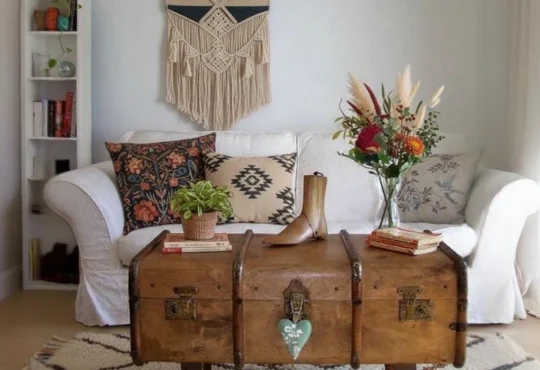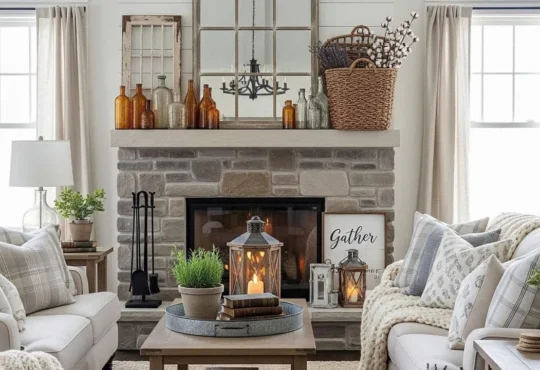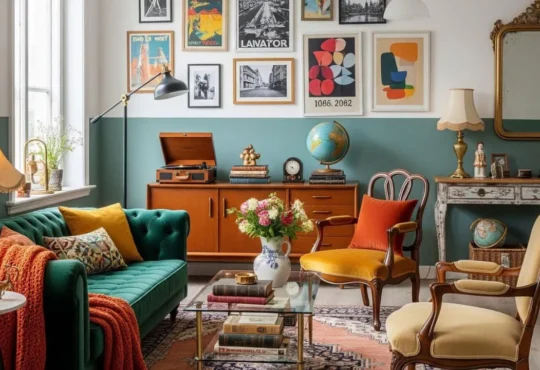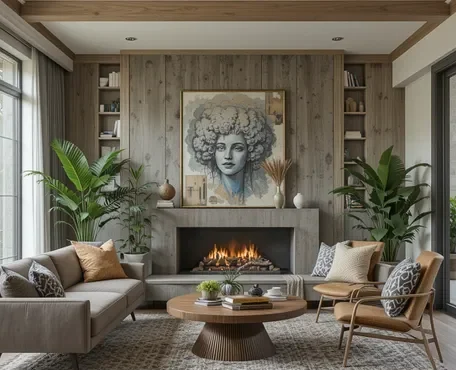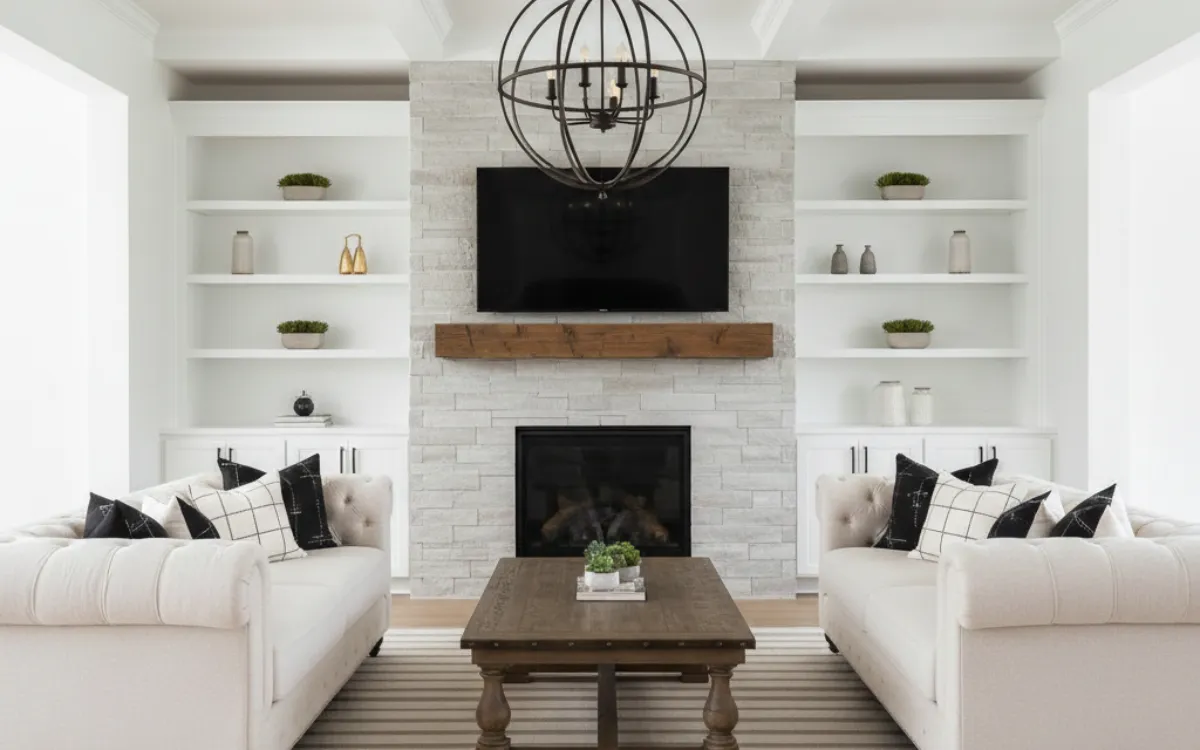
Farmhouse style décor isn’t just a trend—it’s a way of creating a home that feels warm, inviting, and timeless. Rooted in simplicity, functionality, and natural beauty, this style combines rustic charm with modern comfort. From cozy living areas to kitchens that invite family gatherings, mastering farmhouse style means understanding textures, colors, layouts, and personal touches. Here’s a detailed guide with 25 strategies to help you bring the rustic look into your home.
1. Neutral Color Palettes
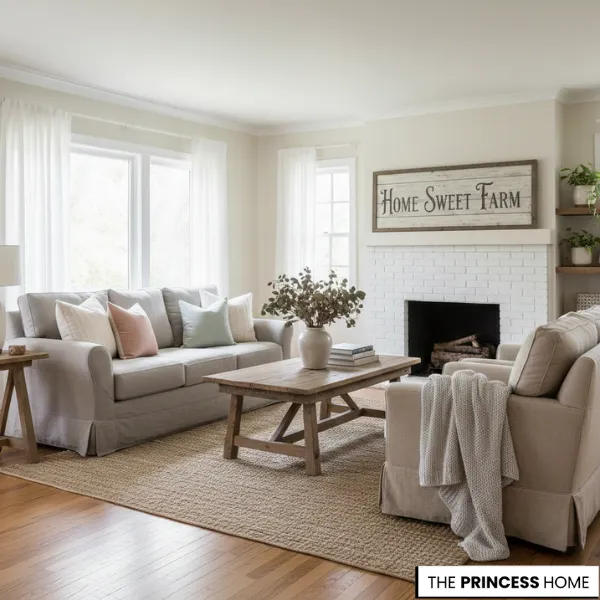
Soft, calming neutrals are the backbone of farmhouse design because they make spaces feel open, warm, and effortlessly welcoming. A neutral foundation also enhances natural light and allows textures—like wood, linen, and metal—to stand out beautifully. For added depth, layer warm whites with earthy undertones, and introduce subtle seasonal colors through artwork, throws, or florals to keep the space feeling fresh without overwhelming the rustic charm.
2. Highlight Wooden Elements

Wood is essential to authentic farmhouse style because it brings warmth, texture, and a lived-in soul to any room. Incorporating reclaimed lumber or vintage wooden pieces adds rich history, unique imperfections, and eco-friendly value that new materials can’t replicate. For a refined rustic balance, mix raw reclaimed accents with smoother, modern finishes to create depth without losing the cozy farmhouse charm.
3. Mix Old and New

Blending rustic charm with modern functionality is what elevates farmhouse style from traditional to timeless. Let vintage pieces set the mood—like an antique dresser, weathered table, or wrought-iron mirror—while clean lines, minimalist lighting, and updated fabrics keep the space current. Focus on two or three standout items per room to create intentional contrast, ensuring the space feels curated, fresh, and effortlessly harmonious rather than cluttered or themed.
4. Opt for Natural Fabrics
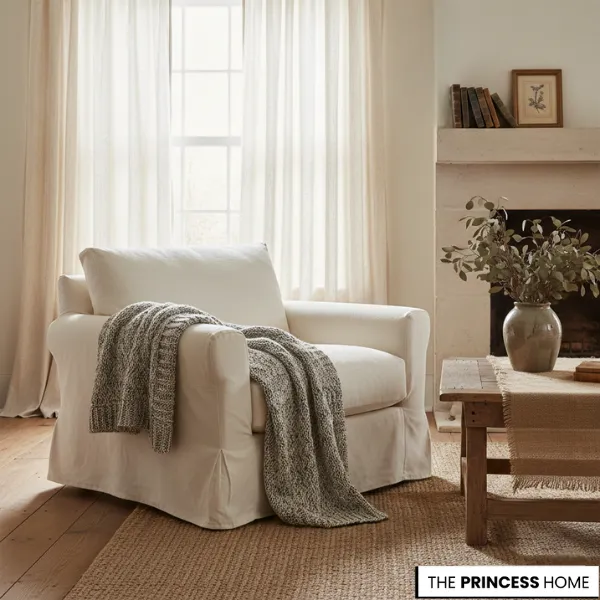
Natural fabrics are essential in farmhouse interiors because they add softness, breathability, and an inviting tactile warmth that synthetic materials can’t match. Linen curtains diffuse light beautifully, cotton slipcovers create a clean and cozy feel, burlap runners add earthy texture, and wool throws bring seasonal comfort. Mixing these materials thoughtfully helps you build a layered, lived-in look that feels both authentic and effortlessly welcoming.
5. Install Farmhouse Sinks

Apron-front sinks instantly anchor a farmhouse kitchen with their sculptural, handcrafted look. Their generous depth isn’t just practical—it reduces splash, protects lower cabinets, and creates a seamless workflow for busy cooks. Choose fireclay or hammered copper for standout durability, and pair them with brushed or matte faucets to achieve a clean, modern-rustic contrast that boosts both style and long-term value.
6. Decorate with Mason Jars

Mason jars bring an authentic farmhouse charm because they blend nostalgia with practical beauty. Their simple glass design makes them perfect for DIY accents—whether you’re turning them into rustic vases, ambient candle holders, or creative pendant lights. For added character, try tinted glass, twine wraps, or vintage-style lids to elevate these everyday jars into stylish, budget-friendly décor elements.
7. Layer Textures

Layering contrasting textures is what gives farmhouse spaces their depth and cozy character. Pairing rough materials like wood, stone, or metal with soft elements such as cotton, wool, or chenille creates a balanced, inviting atmosphere. Aim to style textures in groups of three or five—like a woven basket, a linen throw, and a ceramic vase—to achieve natural visual harmony and a curated, magazine-worthy look.
8. Add Shiplap Walls

Shiplap paneling instantly gives a room that timeless farmhouse character thanks to its clean lines and subtle texture. Painted white, it brightens walls and enhances natural light, while natural or lightly stained wood brings warmth and an authentic rustic feel. For a modern twist, use shiplap as an accent wall or behind open shelving to add depth without overwhelming the space.
9. Use Vintage Lighting
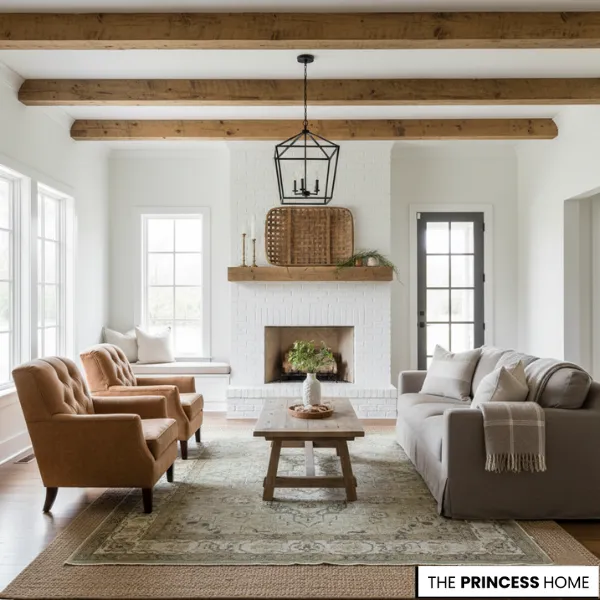
Industrial-inspired lighting anchors farmhouse spaces with a warm, handcrafted feel. Pendant lights, wrought-iron chandeliers, and lantern-style fixtures introduce contrast and vintage charm, while dimmer switches let you shift from bright task lighting to soft, cozy ambiance instantly. For added depth, mix metal finishes—like matte black and aged brass—to give your lighting a curated, modern-rustic edge.
10. Incorporate Open Shelving
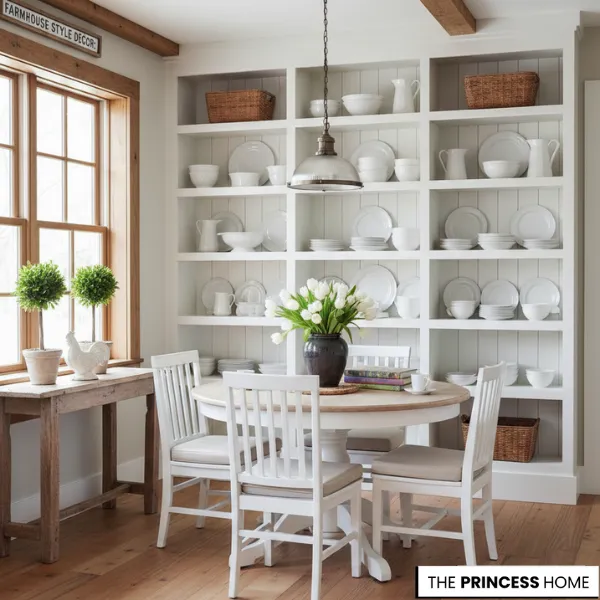
Open shelving adds both functionality and rustic charm by turning everyday items into decorative displays. Use them to feature ceramics, vintage collectibles, or greenery, creating a layered, lived-in feel. For a polished farmhouse look, group items by color, texture, or material, and leave some negative space to avoid clutter while highlighting key pieces.
11. Bring Nature Indoors
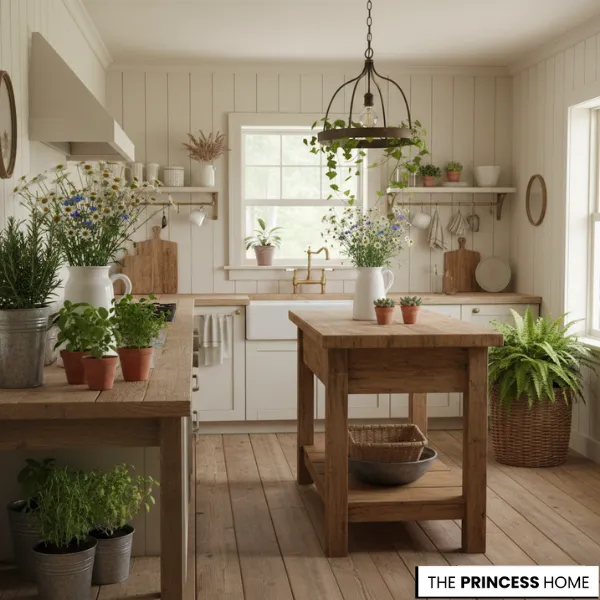
In farmhouse interiors, greenery is more than decoration—it breathes life and adds natural color. Small potted herbs in the kitchen provide both aroma and function, while large leafy plants in living areas soften hard textures and create a vibrant, organic focal point. Rotating seasonal blooms or mixing different plant heights enhances visual interest and keeps the space feeling fresh year-round.
12. Distressed Furniture
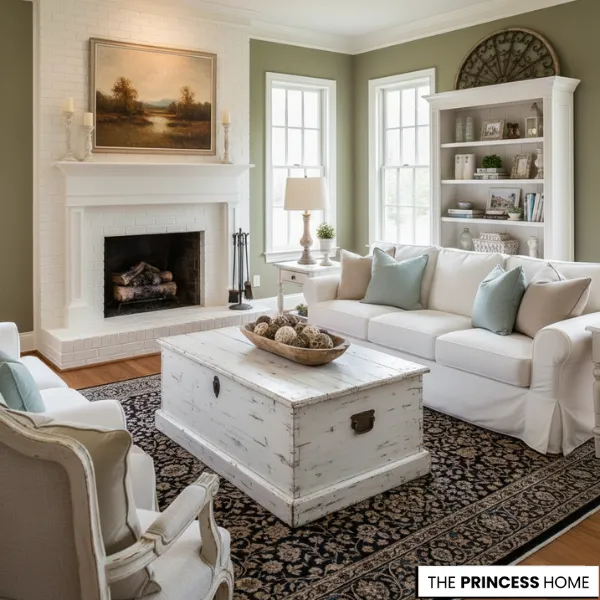
Weathered or distressed furniture instantly adds character and authenticity to farmhouse interiors. Vintage finds, flea market treasures, or DIY distressing techniques showcase history and craftsmanship, making each piece feel unique. Pair these with neutral textiles or modern accents to balance rustic charm with contemporary comfort.
13. Family Heirlooms
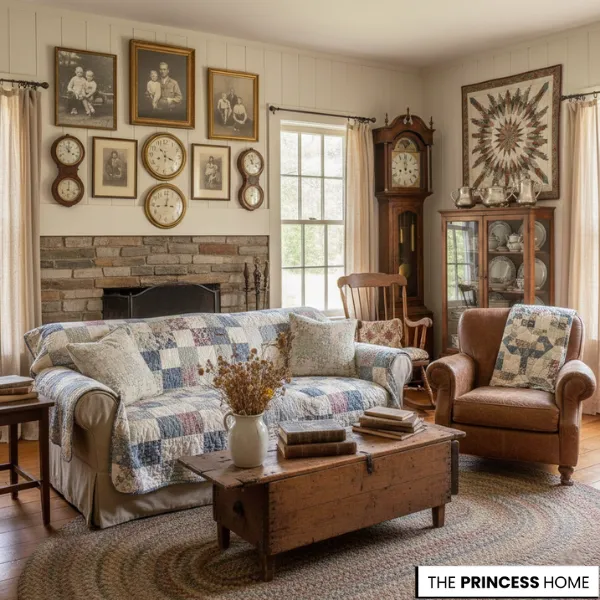
Integrating personal and vintage items—like antiques, handmade quilts, classic clocks, or framed old photographs—adds soul and individuality to farmhouse spaces. These elements tell stories, evoke nostalgia, and make rooms feel warm and truly lived-in, creating a home that’s both stylish and deeply personal.
14. Mix Patterns Thoughtfully

Patterns like gingham, stripes, florals, and checks bring charm and personality to farmhouse décor when used thoughtfully. Keep a cohesive color palette to maintain harmony, and balance scale—large patterns on rugs or throws, smaller motifs on cushions or table linens—to create a layered, visually appealing space without overwhelming it.
15. Add Statement Rugs

Layering rugs—like Persian, braided, or natural fiber options—adds warmth, texture, and a sense of coziness to farmhouse interiors. In open-plan homes, rugs also help define functional zones, creating visual separation between dining, living, or reading areas while enhancing the overall layered, inviting aesthetic.
16.Window Treatments

Light, airy curtains enhance farmhouse interiors by maximizing natural light and creating an open, inviting atmosphere. Choose neutral shades or subtle patterns to complement rustic elements, and consider linen or cotton fabrics for a soft, breezy texture that keeps spaces feeling fresh and effortlessly cozy.
17. Highlight Fireplaces

A fireplace serves as the heart of a farmhouse living space, whether clad in brick, stone, or shiplap. Style the mantle with candles, wooden signs, greenery, or seasonal décor to create a warm, inviting focal point that balances rustic charm with personal character.
18. Farmhouse Tables
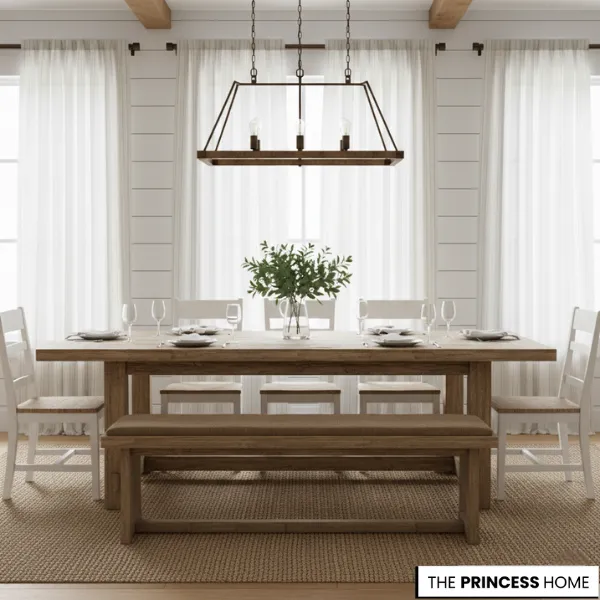
Long wooden tables are central to farmhouse living, offering both practicality and rustic charm. Their generous size encourages family meals and gatherings, while natural finishes and handcrafted details enhance warmth and a sense of timeless, inviting hospitality.
19. Wooden Signs
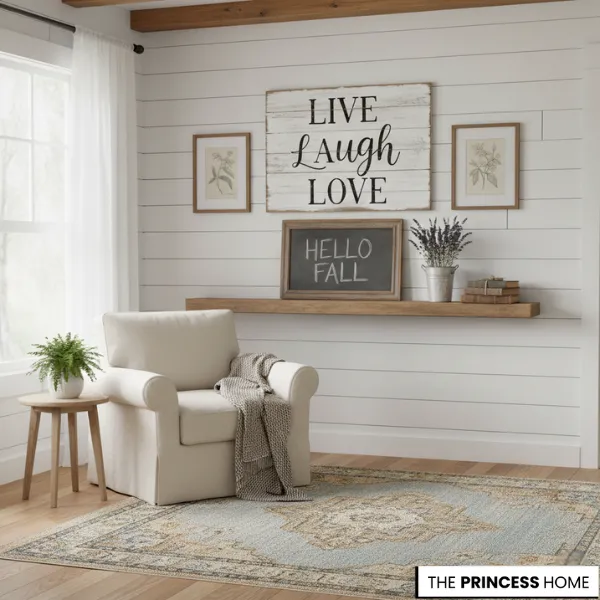
Hand-painted signs, vintage artwork, and chalkboards bring character and a personal touch to farmhouse walls without cluttering the space. Rotating seasonal or motivational pieces adds warmth and storytelling, making rooms feel lively, inviting, and uniquely expressive.
20. Metal Accents

Metal accents like iron, steel, or copper add depth and contrast to rustic farmhouse décor. Use them in drawer pulls, lanterns, light fixtures, or a vintage metal bed frame to introduce subtle industrial charm while complementing natural woods and soft textiles for a balanced, layered look.
21. Cozy Reading Nooks

Create a cozy farmhouse reading nook with a plush armchair, layered cushions, and soft throws for ultimate comfort. Add a small wooden side table and a warm-toned lamp to complete the space, making it inviting for relaxation while enhancing rustic charm and personal style.
22. Outdoor & Indoor Spaces
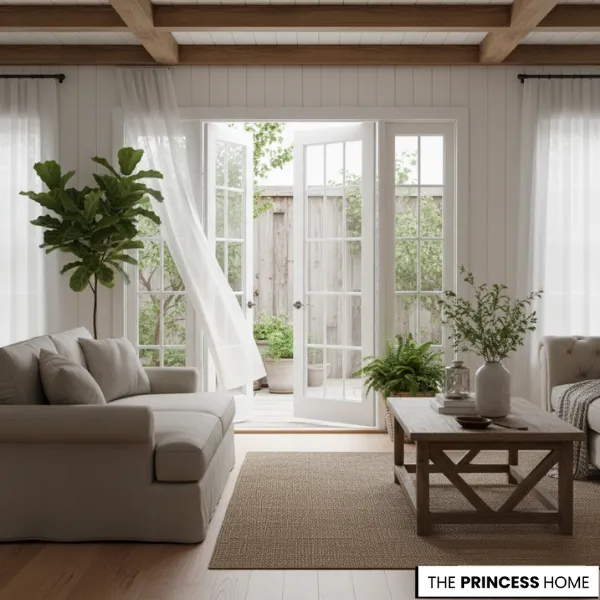
Farmhouse design seamlessly blends indoor and outdoor living, creating airy, welcoming spaces. French doors, rustic patios, and abundant indoor plants help extend the home’s natural flow, bringing light, greenery, and a sense of openness that reinforces the cozy, lived-in charm of the farmhouse aesthetic.
23. Handmade Crafts

Incorporating pottery, woven baskets, and artisanal décor enhances the authenticity of farmhouse interiors. Handmade items showcase craftsmanship and creativity, adding texture, warmth, and a personal touch that makes the space feel thoughtfully curated and uniquely inviting.
24. Emphasize Functionality
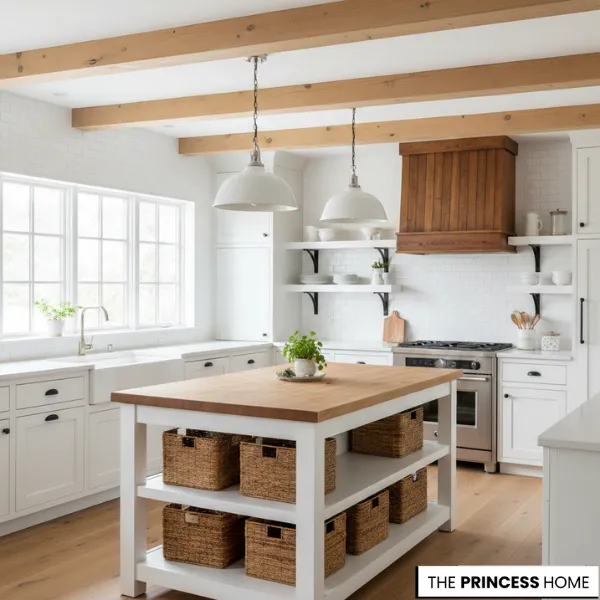
Farmhouse interiors combine charm with functionality, making everyday living effortless. Storage baskets, kitchen islands, and multipurpose furniture offer practical solutions while maintaining rustic appeal, ensuring that spaces are not only beautiful but also highly usable for family life.
25. Keep It Uncluttered
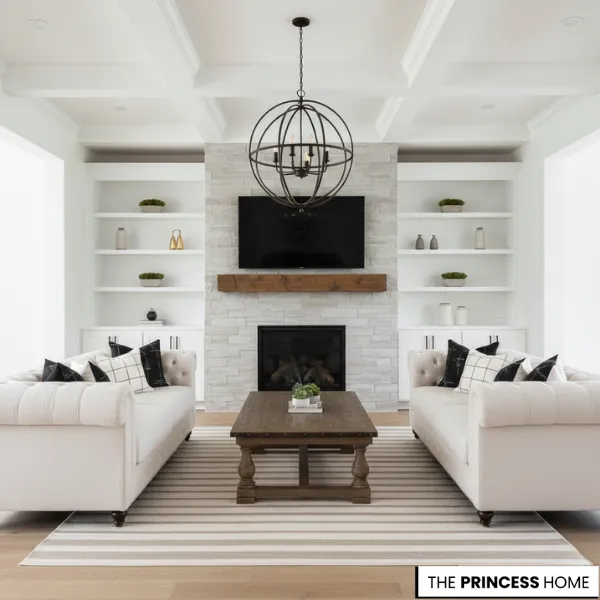
Rustic farmhouse décor shines when simplicity takes center stage. Avoid overcrowding with too many accessories or furniture pieces, letting each item breathe, so rooms feel serene, functional, and effortlessly inviting while highlighting the warmth and character of key elements.
Conclusion
Farmhouse décor celebrates warmth, authenticity, and timeless simplicity. Combining natural materials, neutral colors, vintage accents, and personal touches creates homes that are cozy yet elegant. Focus on balance—mix textures, blend old and new, and embrace imperfections. With these strategies, you can master the rustic farmhouse look while creating a space that feels truly yours.
Here are some frequently asked questions related to the article :
1. What defines farmhouse style décor?
Soft neutral colors, natural textures, vintage furniture, and functional simplicity.
2. Can modern elements fit into farmhouse décor?
Yes. Pair modern lighting, furniture, or appliances with rustic elements for a balanced look.
3. Are bold colors allowed?
Muted accents work best, but deep greens, navy, or mustard can complement neutrals without overwhelming.
4. How do I make a small room feel farmhouse-like?
Use light colors, reflective surfaces, minimal furniture, and layered textures to enhance coziness without clutter.
5. Is farmhouse décor expensive?
Not necessarily. Mix DIY, thrifted items, and key statement pieces to achieve a rustic look affordably.
6. Essential materials for farmhouse style?
Wood, metal, linen, cotton, wool, stone, and glass are staples.
7. How can I personalize my farmhouse home?
Incorporate family heirlooms, handmade crafts, vintage finds, and meaningful décor to add authenticity.
See More Natural & Rustic Styles
The princess home on Pinterest


